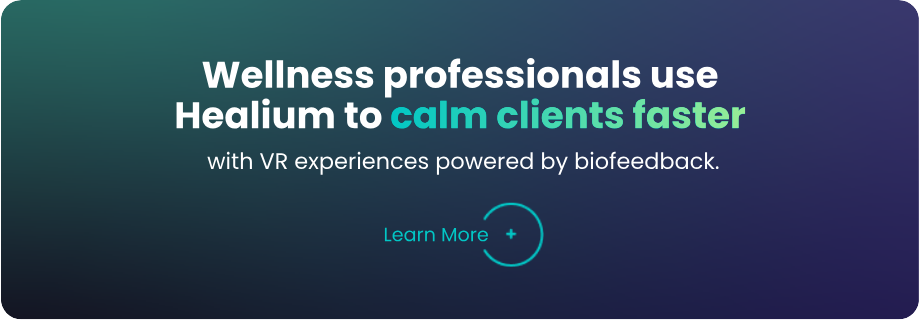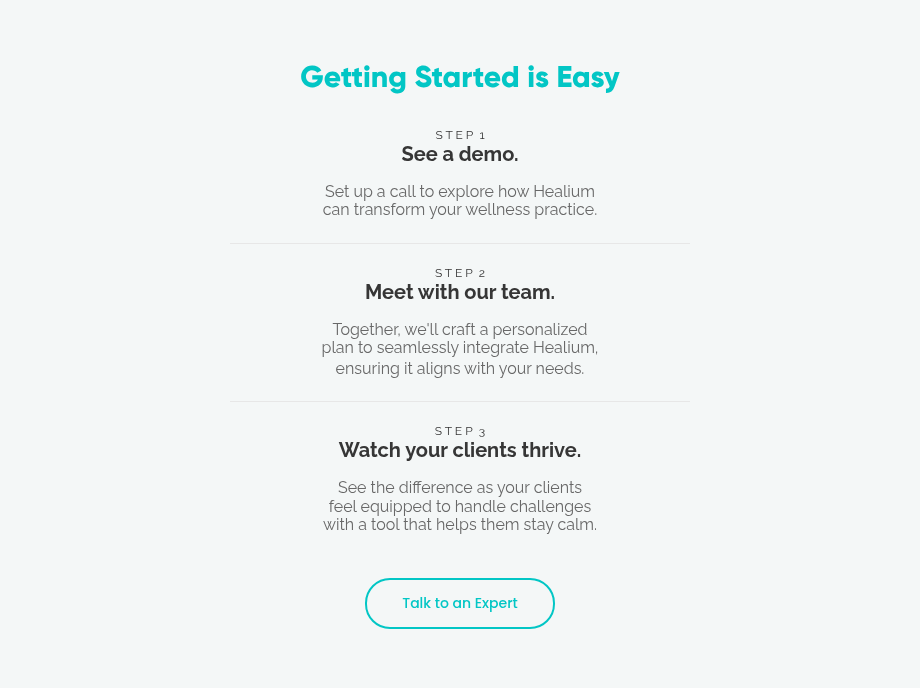What Is Neurofeedback?

Neurofeedback, or EEG (electroencephalography) biofeedback, is a therapeutic intervention that trains your brain by monitoring brainwave activity and providing real-time feedback in visual or auditory form.
Neurofeedback is an educational tool. It's not a diagnostic test or a cure; instead, it’s a method of building self-awareness and strengthening mental wellness.
At Healium, we make neurofeedback practical and engaging by pairing it with virtual reality meditation experiences. This combination turns your brainwave data into a visual story you can see, feel, and improve session by session.
Curious about the difference between biofeedback and neurofeedback? Learn more on our How It Works page.
Neurofeedback Wearables Explained
Not all neurofeedback devices are created equal. Some are designed for clinical diagnostics with dozens of electrodes and advanced mapping tools, while others are consumer wearables that make brain training portable and accessible at home as part of a healthy lifestyle.
In traditional clinical settings, neurofeedback often requires bulky EEG caps with dozens of electrodes, which are powerful for diagnostics, but expensive and impractical for everyday use with clients.
Healium takes a different path. Instead of complex caps, our platform integrates with simple, lightweight EEG headbands such as BrainLink Lite or Muse 2 EEG headbands. While not diagnostic, these devices do capture brainwave activity with just a few sensors across the forehead—no messy gels, no wires, and minimal setup. That makes them easy for practitioners to use with multiple clients in a single day.
The distinction is important:
-
EEG caps: best for diagnostics and qEEG brain mapping in research or hospital settings.
-
EEG headbands (BrainLink Lite, Muse 2): best for scalable neurofeedback training and resilience-building in organizations.
This is why Healium recommends headbands: they strike the balance between reliable data, low cost, and ease of use, which makes them ideal for organizations that need to deliver neurofeedback consistently without the overhead of traditional equipment.

How Does Neurofeedback Work?
At its core, neurofeedback translates brain activity into real-time feedback you can see or hear. This feedback gives clients the ability to recognize their mental state, then adjust it—just like learning to steady your breath during exercise.
Different brainwaves are associated with different outcomes:
-
Alpha waves: relaxation, calm, readiness
-
Beta waves: focus, sustained attention, alertness
By measuring these signals, practitioners can guide clients toward more desirable brain states, reducing stress and self-regulating anxiety through alpha training or improving attention and performance through beta training.
Where Healium fits: our VR meditation environments turn brainwave data into immediate, immersive feedback. If a client drifts out of a calm, focused state, the visuals respond instantly, prompting them to re-center. This makes the training process intuitive, engaging, and easy to scale across organizations.

When Is Neurofeedback Used?
Neurofeedback is used across a wide range of settings, from personal wellness to clinical care. Its flexibility makes it a powerful tool for both individuals and organizations.
-
Individuals: People looking to build resilience, improve focus, reduce anxious thoughts, or enhance sleep quality often turn to neurofeedback as part of their mental fitness routine.
-
Clinicians: Therapists and medical providers use neurofeedback as an adjunct to traditional treatments for ADHD, PTSD, anxiety, depression, insomnia, and other conditions. It can also support patient motivation and engagement during therapy.
-
Educators & Organizations: Schools, hospitals, and corporate wellness programs use scalable neurofeedback solutions like Healium to reduce stress, improve focus, and promote overall mental health at a group level.
In every case, the goal is the same: to train the brain toward healthier patterns.
Explore the Benefits of Using VR for Neurofeedback here!

Neurofeedback in Clinical vs. At-Home Settings
Traditionally, neurofeedback has required clinical environments with EEG caps, qEEG brain mapping, and trained technicians. While powerful, these systems come with high costs. Sessions often start at $125 each, with initial assessments running into the thousands.
For many organizations, this limits accessibility and scalability.
Healium changes the equation. Instead of a multi-electrode cap, our platform works with a lightweight EEG headband that connects directly to immersive VR meditation experiences. This allows schools, clinics, hospitals, and wellness programs to deliver unlimited neurofeedback sessions for a low monthly fee.
Ready to explore how Healium can fit into your organization? Talk to an Expert!
Neurofeedback Results & Success Rates
For certain conditions, clinicians and published research show neurofeedback is likely to be successful in 75%-80% of cases.
At Healium, we're committed to advancing the science behind our platform. Our approach is backed by peer-reviewed research, demonstrating that Healium can:
-
Create positive changes in mood states by the Journal of Neuroregulation
-
Reduce anxiety in as little as 4 minutes by Frontiers in Psychology
-
Increase calmness, happiness, and reduce tension by the Scholarly Journal of Psychology and Behavioral Sciences
-
Increase empathy and compassion in an independent study by Dr. Jeff Tarrant, founder of the Neuromeditation Institute.

Is Neurofeedback Right for You?
Neurofeedback is generally safe, with only mild and short-lived side effects reported in rare cases—things like fatigue, tension, or temporary headaches. For most users, sessions feel like a mental workout: you may feel tired afterward, but in the same way you would after exercising a muscle.
It’s important to note the distinction:
-
For mental fitness and resilience training → Healium offers an easy, scalable way to build calm, focus, and emotional balance.
-
For diagnostic or medical treatment → Clinical neurofeedback with full EEG systems may be more appropriate. In these cases, consult a licensed provider.
Whether you’re an organization looking to support staff or patients, or an individual seeking to improve your own mental fitness, there’s a pathway for you.








